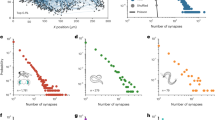Abstract
As shown by A. Rapoport (1952), when a very brief stimulation or “instantaneous input” is applied to a random net, the subsequent events are determined by the parameters of the net as follows: If the axon densitya is sufficiently large and the fraction γ of the neurons initially stimulated exceeds a certain value γ1 (theover-all threshold of the net for instantaneous stimulation), excitation will spread through the net until a steady state is reached in which a fraction γ2 ⩾ γ1 of the neurons is firing (“ignition phenomenon”). If γ < γ1 the activity in the net dies out. However, if the axon density is too small, the activity will ultimately die out, no matter how large the fraction of initially stimulated neurons. Thus there exists a limiting valueA of the axon density below which the net cannot “ignite”. ThisA is a function ofh, theindividual threshold of the neurons constituting the net (we assume hereh≥2, since forh=1 the situation is essentially different). Geometrically γ1 and γ2 are determined as the two intersection points of a straight line with a sigmoid curve. Whena<A the two curves do not intersect and fora=A they are tangent.
In this paper the “tangency case” is investigated and the general features of the functionA(h) are determined. It is shown thatA increases monotonically withh (as one would expect). For all values ofh>1 we haveA(h)>h, but the fractionA(h)/h and the derivativedA(h)/dh approach unity ash increases. An analytical expression of the functionA(h) valid for very large values ofh is derived.
Similar content being viewed by others
Literature
Rapoport, A. 1952. “‘Ignition’ Phenomena in Random Nets.”Bull. Math. Biophysics,14, 35–44.
Whittaker, E. T. and G. N. Watson. 1945.A Course of Modern Analysis. Amer. Ed. New York: Macmillan Co.
Author information
Authors and Affiliations
Rights and permissions
About this article
Cite this article
Trucco, E. The smallest value of the axon density for which ‘ignition’ can occur in a random net. Bulletin of Mathematical Biophysics 14, 365–374 (1952). https://doi.org/10.1007/BF02477852
Issue Date:
DOI: https://doi.org/10.1007/BF02477852




